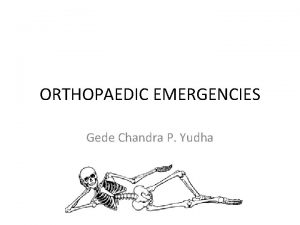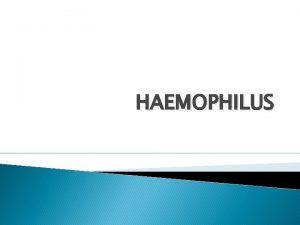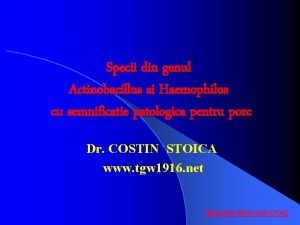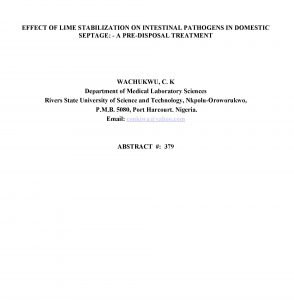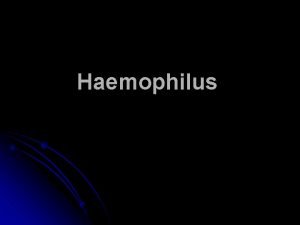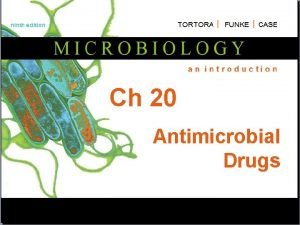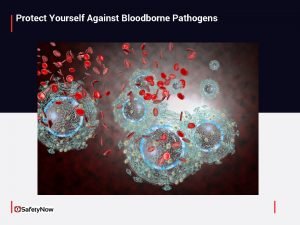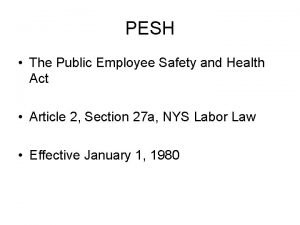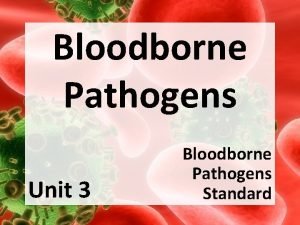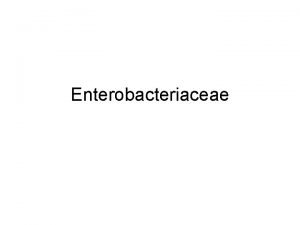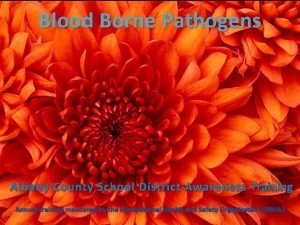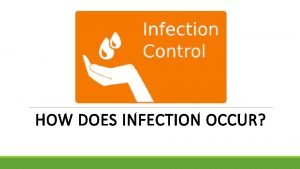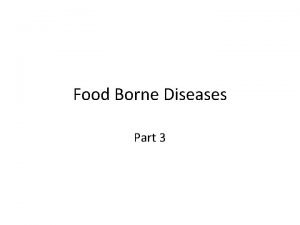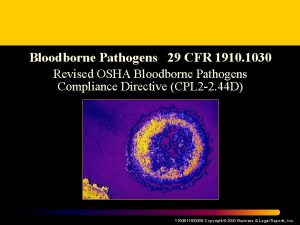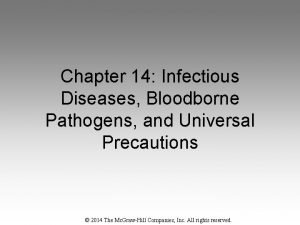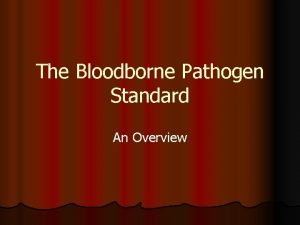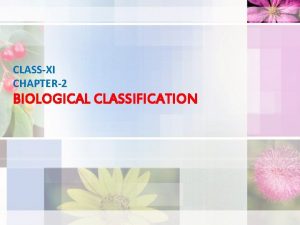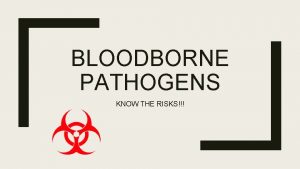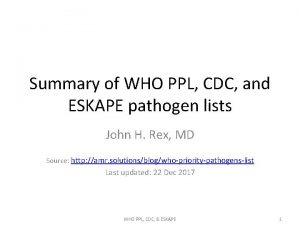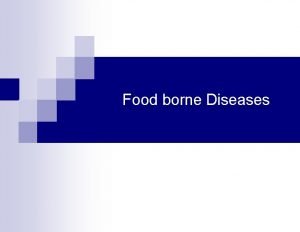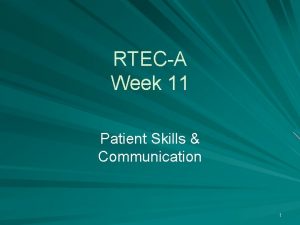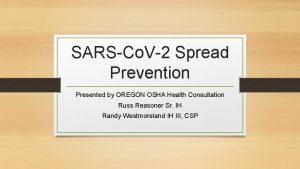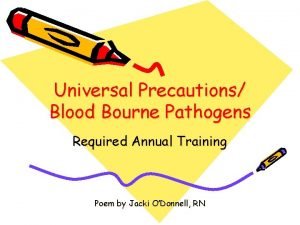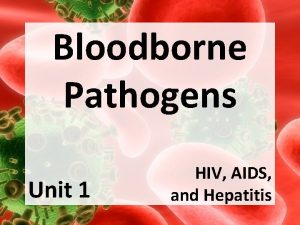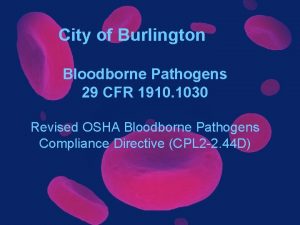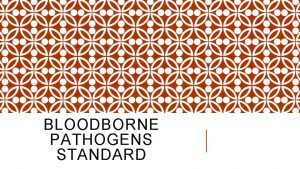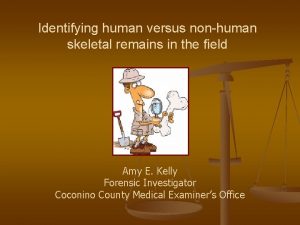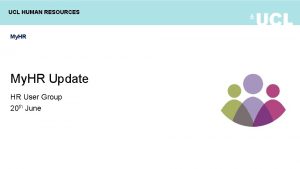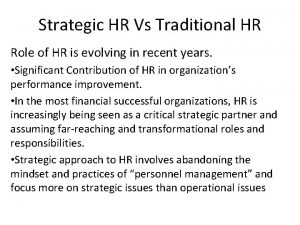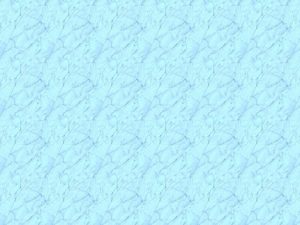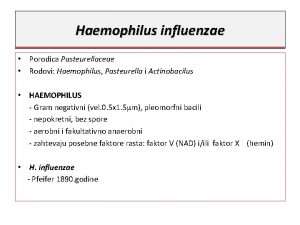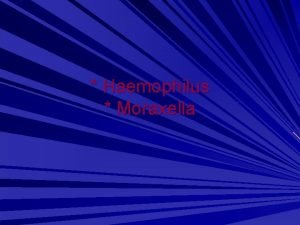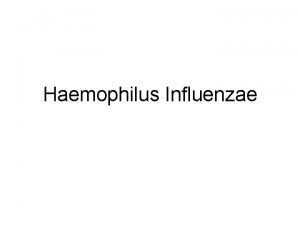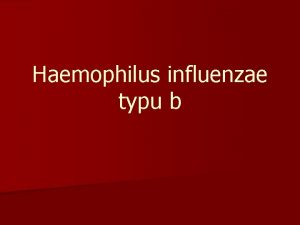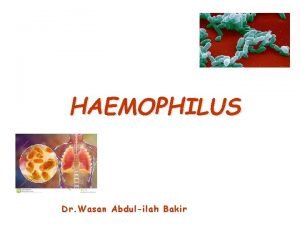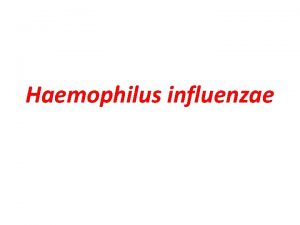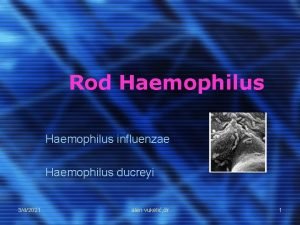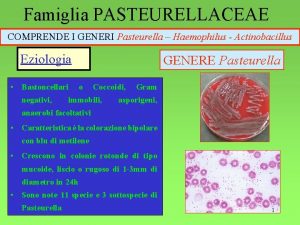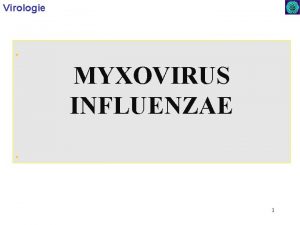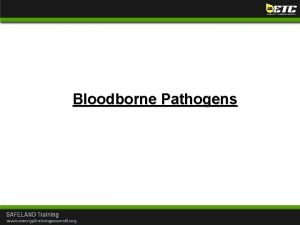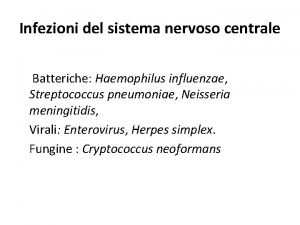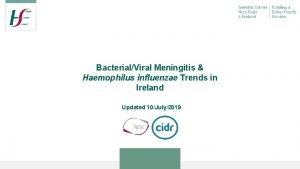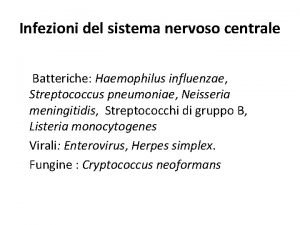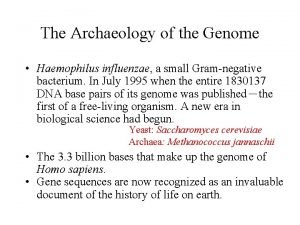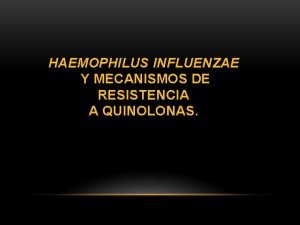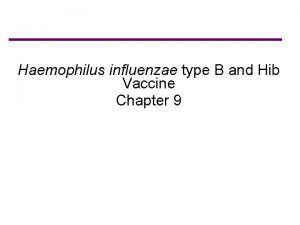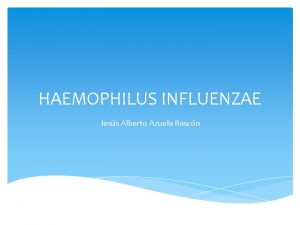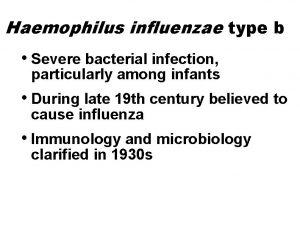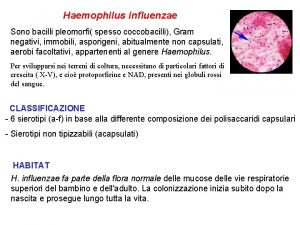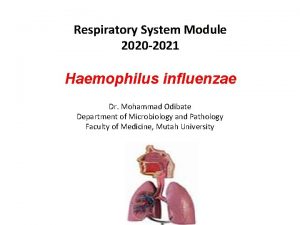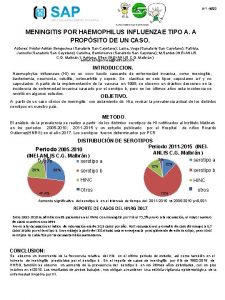Pasteurellaceae Human Pathogens v Haemophilus influenzae v Haemophilus








































- Slides: 40


Pasteurellaceae

Human Pathogens v Haemophilus influenzae v Haemophilus ducreyi v Oppurtunists: Haemophilus parainfluenzae Haemophilus spp. v Pasteurella multocida v Actinobacillus actinomycetemcomitans

Pasteurellaceae General Overview Ø Taxonomic Confusion in Family Pasteurellaceae Ø Three Genera: • Haemophilus: Most Common in Human Disease • Actinobacillus • Pasteurella Ø Haemophilus Ø Common Characteristics of Family • Small (0. 2 x 0. 3 -2. 0 mm) Gram-negative Nonmotile bacilli • Aerobic or facultatively anaerobic • Fastidious growth requirements

Pasteurellaceae Differential Characteristics X factor = hemin (hematin) V factor = (NAD or NADP) nicotinamide adenine dinucleotide


Haemophilus

Haemophilus General Overview Ø Gram-negative bacilli liking blood (as per genus name) Ø Obligate Parasites of Man and Animals Ø Major pathogens for which humans are natural hosts • Haemophilus influenzae üAcute pyogenic, normally invasive infections üChronic infections with H. influenzae as 2 o pathogen • Haemophilus ducreyi üTrue pathogen (i. e. , not found in healthy individuals) üSTD; Soft chancre (chancroid)

Haemophilus Diseases

Haemophilus Infections PRP = polyribitol phosphate (see others in text)

Haemophilus Infections (cont. ) NOTE: üPolysaccharide PRP is weakly immunogenic üPediatric immunity not mature for processing polysaccharide antigens until ~18 months üConjugated Vaccine: PRP conjugated to protein carrier induces protective immunity (carriers may include: diphtheria toxoid, tetanus toxoid or meningococcal OMP)

(per 100, 000) Haemophilus influenzae Incidence NOTE: Dramatic decrease in children <5 years; remains constant in older children

Haemophilus influenzae Diseases

Haemophilus ducreyi Incidence


Actinobacillus

Actinobacillus General Overview Ø Slow-growing; Small; Gram-negative Bacilli Ø Facultatively Anaerobic Ø Require CO 2 for growth on chocolate or blood agar Ø Three Species of Actinobacillus Associated with Human Disease Ø Actinobacillus actinomycetemcomitans is: ü Most serious pathogen of genus ü Hyperadherent in vitro and on damaged heart valves ü Commonly isolated with Actinomyces -comitans is Latin for “accompanying” ü Normal oropharyngeal flora in 20% of healthy people

Actinobacillus Diseases Juvenile & adult Subacute Human


Pasteurella

Pasteurella General Overview Ø Small; Gram-negative; Fermentative Pleomorphic Coccobacilli Ø Facultatively Anaerobic üTherefore infects sutured bites or scratches Ø Pasteurella multocida: üMost common human pathogen üDomestic pets serve as major reservoir üCommensals in upper respiratory tract of dogs, cats, etc. üHuman infection often related to animal bites or scratches or shared food (and you wondered why that lady was buying so much cat food --- it’s cheaper!)

Pasteurella DIseases Three Forms of Disease Ø Localized cellulitis and lymphadenitis following animal bite or scratch Ø In patients with underlying lung dysfunction, worsening of chronic pulmonary disease from aspiration of organisms colonizing patient’s oropharynx Ø Systemic infection in immunocompromised üLiver disease patients at highest risk

Pasteurella Diseases (cont. ) Animal scratch or


REVIEW of Pasteurellaceae

Pasteurellaceae Differential Characteristics X factor = hemin (hematin) V factor = (NAD or NADP) nicotinamide adenine dinucleotide REVIEW

Review of Haemophilus

Haemophilus General Overview Ø Gram-negative bacilli liking blood (as per genus name) Ø Obligate Parasites of Man and Animals Ø Major pathogens for which humans are natural hosts • Haemophilus influenzae üAcute pyogenic, normally invasive infections üChronic infections with H. influenzae as 2 o pathogen • Haemophilus ducreyi üTrue pathogen (i. e. , not found in healthy individuals) üSTD; Soft chancre (chancroid) REVIEW

Haemophilus Diseases REVIEW

Haemophilus Infections (see others in text) PRP = polyribitol phosphate REVIEW

Haemophilus Infections (cont. ) NOTE: üPolysaccharide PRP is weakly immunogenic üPediatric immunity not mature for processing polysaccharide antigens until ~18 months üConjugated Vaccine: PRP conjugated to protein carrier induces protective immunity (carriers may include: diphtheria toxoid, tetanus toxoid or meningococcal OMP) REVIEW

(per 100, 000) Haemophilus influenzae Incidence NOTE: Dramatic decrease in children <5 years following use of PRP conjugated vaccine; Disease rate remains constant in older children REVIEW

Haemophilus ducreyi Incidence REVIEW

Review of Actinobacillus

Actinobacillus General Overview Ø Slow-growing; Small; Gram-negative Bacilli Ø Facultatively Anaerobic Ø Require CO 2 for growth on chocolate or blood agar Ø Three Species of Actinobacillus Associated with Human Disease Ø Actinobacillus actinomycetemcomitans is: ü Most serious pathogen of genus ü Hyperadherent in vitro and on damaged heart valves ü Commonly isolated with Actinomyces -comitans is Latin for “accompanying” ü Normal oropharyngeal flora in 20% of healthy people REVIEW

Actinobacillus Diseases Juvenile & adult Subacute Human REVIEW

Review of Pasteurella

Pasteurella General Overview Ø Small; Gram-negative; Fermentative Pleomorphic Coccobacilli Ø Facultatively Anaerobic üTherefore infects sutured bites or scratches Ø Pasteurella multocida: üMost common human pathogen üDomestic pets serve as major reservoir üCommensals in upper respiratory tract of dogs, cats, etc. üHuman infection often related to animal bites or scratches or shared food (and you wondered why that lady was buying so much cat food --- it’s cheaper!) REVIEW

Pasteurella DIseases Three Forms of Disease Ø Localized cellulitis and lymphadenitis following animal bite or scratch Ø In patients with underlying lung dysfunction, worsening of chronic pulmonary disease from aspiration of organisms colonizing patient’s oropharynx Ø Systemic infection in immunocompromised üLiver disease patients at highest risk REVIEW

Pasteurella Diseases (cont. ) Animal scratch or REVIEW
 Streptococcus gram negative
Streptococcus gram negative Prueba bioquimica catalasa
Prueba bioquimica catalasa Haemophilus influenzae septic arthritis
Haemophilus influenzae septic arthritis Haemophilus influenzae
Haemophilus influenzae Genul haemophilus
Genul haemophilus Major human pathogens
Major human pathogens Human pathogens and toxins act
Human pathogens and toxins act Liking blood
Liking blood Inhibition of nucleic acid synthesis
Inhibition of nucleic acid synthesis How to protect yourself from bloodborne pathogens
How to protect yourself from bloodborne pathogens Exposure control plan
Exposure control plan Unit 3 bloodborne pathogens standard
Unit 3 bloodborne pathogens standard Enteric bacteria definition
Enteric bacteria definition Bloodborne pathogens awareness training
Bloodborne pathogens awareness training Flora bloodborne
Flora bloodborne An exogenous disease originates outside the body.
An exogenous disease originates outside the body. Food borne pathogens
Food borne pathogens Bloodborne pathogens standard 29 cfr 1910
Bloodborne pathogens standard 29 cfr 1910 Chapter 14 worksheet bloodborne pathogens
Chapter 14 worksheet bloodborne pathogens Osha's bloodborne pathogens standard covers
Osha's bloodborne pathogens standard covers Holozoid
Holozoid Bloodborne pathogens know the risk
Bloodborne pathogens know the risk Eskape pathogens cdc
Eskape pathogens cdc Food borne pathogens
Food borne pathogens Blood borne pathogens
Blood borne pathogens Osha safety pyramid
Osha safety pyramid Blood bourne pathogens
Blood bourne pathogens Bloodborne pathogens attacking the liver are
Bloodborne pathogens attacking the liver are All cuts should be
All cuts should be Bloodborne pathogens quiz answers
Bloodborne pathogens quiz answers Exposure control plan bloodborne pathogens
Exposure control plan bloodborne pathogens Human development index definition ap human geography
Human development index definition ap human geography Human vs non human bones
Human vs non human bones Human nouns
Human nouns Human needs and human development chapter 8
Human needs and human development chapter 8 Chapter 8 human needs and human development
Chapter 8 human needs and human development Myhrucl
Myhrucl Homopolymer tailing
Homopolymer tailing Biomass fuel definition ap human geography
Biomass fuel definition ap human geography Traditional hr structure
Traditional hr structure Kyrene homepage
Kyrene homepage


